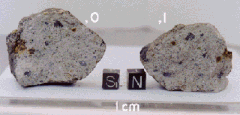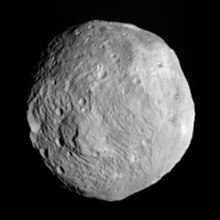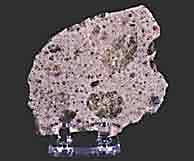

| HED meteorite | |
|---|---|
| — Clan — | |

| |
| Type | Stony |
| Class | Achondrite |
| Subgroups |
|
| Parent body | Vesta |
 QUE 94200, howardite | |
HED meteorites are a clan (subgroup) of achondrite meteorites. HED stands for "howardite–eucrite–diogenite". These achondrites came from a differentiated parent body and experienced extensive igneous processing not much different from the magmatic rocks found on Earth and for this reason they closely resemble terrestrial igneous rocks.[1]
HED meteorites are broadly divided into:
Several subgroups of both eucrites and diogenites have been found.[2][3]
The HED meteorites account for about 5% of all falls,[4] which is about 60% of all achondrites.[5]


No matter their composition, all these types of meteorite are thought to have originated in the crust of the asteroid Vesta.[6][7] According to this theory, the differences of composition are due to their ejection at different moments in the geologic history of Vesta. Their crystallization ages have been determined to be between 4.43 and 4.55 billion years from radioisotope ratios. HED meteorites are differentiated meteorites, which were created by igneous processes in the crust of their parent asteroid.
It is thought that the method of transport from Vesta to Earth is as follows:[8]
|
| |||||||||||||||||||||||
|---|---|---|---|---|---|---|---|---|---|---|---|---|---|---|---|---|---|---|---|---|---|---|---|
| Meteorite... |
| ||||||||||||||||||||||
| Classification |
| ||||||||||||||||||||||
| Mineralogy and petrology |
| ||||||||||||||||||||||
| Lists |
| ||||||||||||||||||||||
| |||||||||||||||||||||||